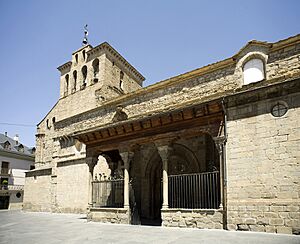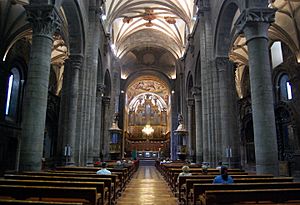Jaca Cathedral facts for kids
Quick facts for kids Jaca Cathedral |
|
|---|---|
| Cathedral of Saint Peter | |
| Catedral de San Pedro | |

South façade
|
|
| 42°34′13.8″N 0°32′56.8″W / 42.570500°N 0.549111°W | |
| Location | Jaca |
| Country | Spain |
| Denomination | Catholic |
| History | |
| Status | Cathedral |
| Dedication | Saint Peter |
| Architecture | |
| Style | Romanesque, Gothic |
| Years built | 1077—1130 |
| Administration | |
| Metropolis | Pamplona and Tudela |
| Diocese | Jaca |
The Cathedral of Saint Peter (also known as Catedral de San Pedro in Spanish) is a big Catholic church in Jaca, Spain. It's a special kind of church called a cathedral, which means it's the main church for the Diocese of Jaca.
This cathedral is super old! It was the very first Romanesque cathedral built in a region of Spain called Aragon. It's also one of the oldest cathedrals in the whole Iberian Peninsula (that's where Spain and Portugal are). The cathedral you see today has many parts added later. These changes happened mostly between the late 1400s and late 1700s. King Sancho Ramírez ordered the cathedral to be built. He got permission from Pope Alexander II in 1068 to make Jaca a special church city. Jaca was the capital of the Kingdom of Aragon back then.
Contents
History of Jaca Cathedral
How the Cathedral Began
Jaca became the capital city of Aragon in 1036. Then, in 1077, it was made an important church city. This meant they needed to build a grand cathedral. We don't know the exact date when building started. But most people think it was around 1077. The main part of the church was finished by about 1130.
Changes Over Time
In 1395, a fire badly damaged the cathedral's roof. It was rebuilt in the years that followed. In the early 1500s, the roof was updated again. During this time, more side sections were added. The main central part of the church was also made bigger.
Later, during the Baroque period, more parts were added. These included the St. Horosia Chapel and a special covered walkway called a loggia. A cloister, which is a covered walkway around a courtyard, was also built. Inside, the church got a new altarpiece and other beautiful decorations. In the late 1700s, one of the rounded ends of the church was taken down and rebuilt. The main rounded end was also updated.
What Does Jaca Cathedral Look Like?
Main Design and Styles
The Jaca Cathedral mostly has a Romanesque design. But you can also see parts that are Gothic, Renaissance, and Baroque in style. The church has a main central area and two side areas. It also has three rounded ends called apses. There are two main entrances outside, both with loggias. One of these loggias is in the Renaissance style. Only one of the current apses is from the original building. The central apse was updated in the 1700s. The third apse was completely rebuilt around the same time.
Inside the Cathedral
The main area and side areas of the church are separated by arches. These arches are held up by large pillars. Some pillars are shaped like a cross, and others are round. This design was inspired by churches in France from that time. The tops of the pillars, called capitals, are in the Corinthian style. They have carvings of plants and geometric shapes. The ceiling was originally made of wood. Now, it has cross vaults, which are arched stone ceilings. The large dome in the middle of the church is shaped like an octagon.
Chapels and Artworks
There are several chapels built around the sides of the cathedral. These were added between the late 1400s and mid-1600s. The older chapels, like those for the Holy Cross and St. Augustine, are in a late Gothic style. Chapels built in the 1500s, such as St. Michael and St. Jerome, show Renaissance and Mannerist influences. The chapel of St. Horosia was completely redone in the 1700s. It is a beautiful example of Baroque style.
Inside, you can find amazing artworks. The altarpiece in the St. Michael Chapel is one example. It was carved by artists like Gil Morales the Younger and Gabriel Yoli. Juan de Salas and Giovanni de Moreto also worked on it. Giovanni de Moreto also led the building of the chapel. This chapel is considered one of the best examples of Renaissance-Plateresque art in Aragon. The altarpiece for the main altar was finished in the early 1600s. The decorations in the central apse were painted by Manuel Bayeu in 1792–1793. Manuel Bayeu was the brother-in-law of the famous artist Francisco Goya.
See also
 In Spanish: Catedral de San Pedro de Jaca para niños
In Spanish: Catedral de San Pedro de Jaca para niños
- Roman Catholic Diocese of Jaca







